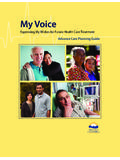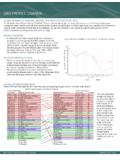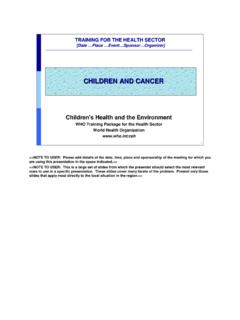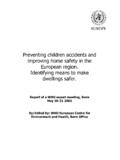Transcription of Preventing Injury in Child Care Settings - British Columbia
1 Preventing Injury in Child care Settings BCHealthPlanning Preventing Injury in Child care Settings For more information, please contact the: Ministry of Health Planning Community care Facilities Branch Victoria BC V8W 3C8. This booklet can also be viewed on the internet, at: Canadian Cataloguing in Publication Data Main entry under title: Preventing Injury in Child care Settings Includes bibliographical references; p. 26. ISBN 0-7726-1995-6. 1. Day care centers - British Columbia - Safety Measures. 2. Children's accidents - British Columbia - Prevention. 3. Safety education - British Columbia . I. British Columbia . Community care Facilities Branch. II. British Columbia . Office for Injury Prevention III. Westcoast Child care Resource Centre 1993 '07 C94-960009-1. Table of Contents Introduction .. 1. A. Injury Prevention .. 3. Setting the Stage Active and Positive Supervision Safe Space Arrangement Developmentally Appropriate Programming and Activities Preventive Policies and Procedures B.
2 Child Proofing Indoor Settings .. 9. Furnishings Toys Windows Walkers Phones Kitchens Plants Sleeprooms Hazardous Materials Bathrooms Hallways and Stairways Gyms or Gross Motor Areas Gates and Doors Family Day care Wiring, Electric Plugs & Appliances Coping With Crisis C. Childproofing Outdoor Settings .. 18. Comings and Goings Plants Traffic Paths Pools and Ponds Equipment Field Trips Resilient Surfaces Injury Prevention Checklist .. 23. References, Readings and Resources .. 27. Introduction unintentional injuries are the single leading cause of death for British Columbia children and youth aged 1-24. On average, a British Columbia Child or youth is hospitalized every 40 minutes due to an unintentional Injury . Each year more than 260 children are killed and over 12,000 children are hospitalized as a result of unintentional injuries . We are concerned about the safety of our children.
3 Whether the setting is a family day care home, a preschool, a group day care , other community Settings , or parent's home, the principles and practices of Injury Prevention serve as a foundation for ensuring children's safety. The Government of British Columbia has placed increasing priority on the prevention of injuries and illness. The Ministry of Health's PreventionCare initiative builds awareness of the extent to which Injury and illness are preventable and encourages British Columbians to take action to protect themselves and their families. This handbook provides an overview of the attitudes, knowledge and skills required by caregivers in their day-to-day work with children from birth through six years of age. It offers a practical framework for understanding childhood injuries and concrete suggestions for avoiding them! Parents will also find the information useful in Child -proofing their own homes as well as checking the Child care Settings they have chosen for their children.
4 For readers who wish to pursue Injury Prevention Issues in more depth, a bibliography and resource list are included. 1. A. Injury Prevention Setting the Stage Did you know .. the vast majority of injuries are predictable and preventable. most injuries to young children result from burns, poisoning and choking or suffocation. most injuries to young children occur in the late afternoon or early evening when they are tired. injuries in early childhood Settings occur more frequently at arrival and departure times than at other times of day. children are more likely to suffer injuries when they are unfamiliar with a setting. Learning, exploring and developing new skills always involve some challenge and often, some risk! It is our responsibility to ensure the safest environment possible. Planning for children's safety is the most effective tool for Preventing injuries . A systematic approach to planning involves: Active and Positive Supervision Safe Space Arrangement Developmentally Appropriate Programming and Activities Preventive Policies and Procedures 3.
5 Active and Positive Supervision Adults who are involved, aware and appreciative of young children's behaviours are in the best position to safeguard their well-being. Here are some things to consider: Know each Child 's abilities Jennifer, a very active two year old, is fascinated with climbing but has not yet mastered the skill of coming down the ladder. Carlos, also age two, can manage this very well. Establish clear and simple safety rules "Inside we walk", "We climb up the ladder and come down the slide" and "Our toys stay on the ground when we climb" are rules that young children can understand. Be aware of potential hazards The log in the play yard is a source of much imaginative play. However, after a heavy rain or cold spell, the log is slippery and therefore "off limits" to the children. Position yourself strategically Standing nearby or being in the block play will encourage Sally to remember the rule "Your building can be as tall as you are" and discourage Michael from throwing blocks in frustration.
6 Your presence not only serves as a reminder but also enables you to intervene quickly when needed. Scan and circulate Looking "up and out" and moving "with the action" are the best ways to be aware of the group as a whole and to anticipate potential trouble spots. Facing the open play space while sitting at the art table enables you to move quickly to the climber when you see the line-up growing. Focus on the positive rather than the negative Telling Dianne "Keep the water in the bucket" rather than "Don't splash the water" teaches her what is safe for herself, others and the environment. 4. Redirect Paul, a toddler, has a tendency to bite when frustrated. Knowing this and positioning yourself close at hand will enable you to offer him a hard, plastic biting toy when needed. With Susy, a two year old who has a tendency to hit others when angry, you might redirect her to the playdough table to "pinch and punch" something that cannot be hurt.
7 Safe Space Arrangement Careful planning for children's play spaces can minimize the risk of Injury . Here are some helpful suggestions: Consider traffic flow In arranging your learning centres, try to avoid long corridors or large open spaces in the centre of the room. Both of these can lead to overly excited play or running. Define play spaces Heavy plastic sheets under the water and sand tables will confine the play, prevent slipping or falling and enable easy clean up. Placing a border around the swings will ensure safety not only for the "swingers" but for children involved in other activities. Arrange the sleep area Spacing sleep mats at least two feet apart will provide a path for children to walk easily and safely. Providing night lights in a darkened sleep room also will prevent tripping. Plan for flexibility When many children are excited about building a large block structure, consider pushing back a shelf unit.
8 This will create a safer play space by avoiding congestion and decreasing frustration. 5. Developmentally Appropriate Programming and Activities Plan and offer activities which match the needs, skills and abilities of the children in your care . Here are some helpful strategies: Provide appropriate activities While toddlers enjoy placing precut vegetable pieces in a soup pot, preschoolers can actually wash, peel and cut fruit for a salad. While preschoolers welcome the challenge of hammering real nails into a piece of wood, toddlers are safe and satisfied with using a hammer and peg set. For toddlers, walking along a strip of masking tape on the floor provides a safer choice than balance beams which are more for preschoolers. Consider size and manageability Children's height, strength and physical abilities are key factors when selecting tricycles, mounting hooks in cubbies or deciding to purchase chairs with or without sides.
9 Similarly, the size and weight of equipment such as balls, boxes and toys should ensure safe lifting, carrying or stacking. When working with very young children, avoid small objects which could be easily swallowed or put in their ears or nostrils. Plan field trips with safety in mind Ensure the equipment in your neighbourhood park is suitable for the ages and developmental stages of your children. Always try to select a route for your outing where crosswalks are clearly marked and driveways are fewer. Make sure there will be enough adult assistance to provide close supervision. Teach and review safety rules prior to your trip. 6. Preventive Policies and Procedures Just as with all other areas of Child care , policies for Injury prevention define what to do and procedures outline how best to do it! These should be included in your Policies and Procedures Manual. The following examples illustrate policies and procedures which may be adopted for your setting.
10 Policy: Field trips for our over 3 group require one adult for every three children. Procedure: Prior to the field trip, a staff member will take responsibility for enlisting help from parents substitutes and/or volunteers. Policy: An Injury prevention check will be completed every six months. Procedure: Using the Injury prevention checklist form, the condition of all indoor and outdoor equipment will be recorded and reported to the Equipment Chairperson. Any unsafe items will be removed or "off limits" until repairs are made. Policy: A Reportable Incident form will be completed within 24 hours of the Injury /incident. Procedure: Staff present at the time of Injury /incident will be responsible for: notifying the parents/guardians completing and signing the form filing the original at the facility and submitting one copy to the licensing officer Policy: All staff will have current First Aid certificates.
















